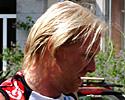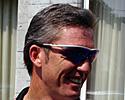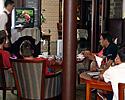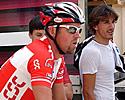
Recently on Cyclingnews.com |
Team CSC's July training camp, part one
Keeping a winning formula
Team CSC management are big believers in the merits of training camps. After their July 2005 training camp Allan Johansen and Christian Müller followed up on their week of hard labour in the Austrian hills by winning two stages in the Sachsen Tour - a two-trick feat that Andy Schleck repeated this year. During the second part of last season, the team performed strongly in the Tour of Denmark, the Hew Classic, the Benelux Tour, the Tour de l'Avenir and the Vuelta. CSC manager Bjarne Riis likes to keep a winning formula, as Sabine Sunderland found out.

|
After having taken the team to Denmark for a training camp in December, followed by a 10-day meeting in Tuscany in January and a fine-tuning training session of another ten days in Solvang, California in February, training camps might have become a bit of a drag for the riders you'd think. But not for the CSC riders.
While Carlos Sastre and his team-mates were doing an outstanding job in the Tour de France, DS Scott Sunderland again got handed the responsibility to plan the seven days of intense training for the rest of the squad.
"There's several factors which contribute to an efficient training camp," said Sunderland. "The location, what the weather will be like in that area, the training parcours, the ease of travel to and from the hotel and so on. You need to synchronise everything to make sure that you have all ingredients in place for a smooth run. It does take some serious planning."
Sunderland gathered the CSC troops at The Radisson SAS Balmoral hotel in Spa, Belgium. Nestled amidst the lovely forests of the Belgian Ardennes, it is a charming and cosy four-star hotel. Spa, famous for its natural thermal springs was no doubt an ideal location to put some long and hilly kilometres in and ride some of the well-known climbs of the Liege-Bastogne-Liege parcours in preparation for the second part of the season.
Director Sportif Dan Frost, mechanics, soigneurs and the 22 riders arrived on the afternoon on Sunday the 9th of July. The majority of the riders were coming off a rest period after already having raced 60-70 days this season. A few were still on the road to recovery after injury or illness.

|
A mid-season training camp takes a considerable bite out of any ProTour teams's budget so some teams don't bother but Riis believes strongly in the merits of this type of training camp. Sunderland agrees with Riis's approach to the matter and explains how it's all part of team's philosophy, "The primary aim of the training camp is to get the riders together. With a team of 30 riders, it's difficult to have another opportunity mid-season for this. Some riders and personnel haven't seen each other since the last training camp in February.
"Indeed, while part of the team is at the Tour de France the other riders are having a quiet period so it's the ideal time to assemble all the other team members.
"Also, besides the training in group, we like to cheer on our team in the Tour together. The riders would otherwise be at home in front of the television, but I can assure you it's great fun to watch the race together." Sunderland laughed. Indeed, a couple of days into the training camp, Jens Voigt's magnificent victory was celebrated in a very enjoyable atmosphere of camaraderie; quite a unique experience.

|
The social aspect of this week spent in the Belgian Ardennes is only one of the numerous reasons for the camp, "We get to talk about schedules, individual training programs and all sorts of things." Sunderland added. "The riders get to do specific work, like power, strength and race simulation training. A lot of it is based on the type of racing which will be done in the coming weeks."
Although the training schedule looked similar to that of earlier camps with five to six hours of riding every day, the actual work done on the bike wasn't the same as in the earlier camps.
Sunderland was keeping a close eye on the riders during their rides. He was joined by Dan Frost in the first team car while he took notes. One might wonder why it is so essential for the team directors to see the riders during training. There are the younger riders, who need professional coaching and training advice, but most of the riders in the Pro Tour teams are experienced pro's who've been racing at the highest level for some years.

|
There's more to it than meets the eye of the outsider, "When you can join a rider on his training ride you get so much information. After observing him training and racing for some time you really get to know a rider. You notice more easily how they feel, before, during and after their performance. Actually following them out training at this time, gives a much better perspective on where they are, how their form is. At this time of the year it's vital to know the stats so they can be interpreted with the rest of the season in mind," Sunderland explained.
"There's even a lot to tell by how they look before and after the rides. At the breakfast table I can tell by looking at their faces how they have digested their training the previous day. It shows how they are adapting and recuperating. Sometimes we might have to alter personal training and racing programs accordingly. Young riders may benefit from nutritional advice, or want to talk to us about other issues, learn about how to manage their stressors for example. There's so much that can be taken care of during our time together.

|
It might sound strange but after racing successfully for years, it's sometimes good for a pro to alter training habits to trigger the physical and mental growth of that rider. As a matter of fact, it's amazing to see which beautiful result a complete change of training method might accomplish in a rider who's stuck in his growing process. If you make the right moves, it could get that rider to perform at a higher level.
Besides that, psychological fitness is as important as the physical condition, "There's no doubt any drastic changes have to be executed with care and most of all with full commitment from both parties - the manager and rider," said Sunderland.
"Although the directors keep in touch with their designated riders during their time at home, sometimes it's good to sit down and talk face-to-face. Also for that reason a mid-season training camp is very effective."
The rest day, at the race track
The gods offered the CSC Team splendid weather during their week of hard work; with temperatures hovering around 28 to 30°C. The men returned tired but happy after every ride. Soigneurs and mechanics were pleased with the weather conditions as well, as working in the rain is never pleasant.

|
When there's so much motivation and dedication to the hard work, there is no way some play can be omitted from the schedule. After three days of intense labour on the bike, a rest day was greeted with enthusiasm. Team director Tristan Hoffman came to spend the day with the rest of the team, and the riders and staff went for a cruise on their bikes for a couple of hours.
Lunch followed and then the team bus and all five of the team cars went in convoy to Circuit de Spa-Francorchamps. This is the famous venue of the Formula One Belgian Grand Prix and the Spa 24-hour endurance race. It is considered to be one of the most challenging race tracks in the world, mainly due to its hilly and twisty nature. The circuit features one of the most dangerous sections of any racing track in the world, the Eau Rouge complex.
Spa is the most favoured circuit of the majority of racing drivers and fans alike and Sunderland had organised for the whole team to be taken on a tour of this roller-coaster track which, "courses along the contours of the Ardennes mountains with a beautiful natural flow" as Rudy - the guide from Adrenaline Events - pointed out.
A visit to the air-conditioned control room was greatly appreciated and the walk through the paddocks gave the team the opportunity to admire many of the racing cars gearing up for the Spa Historic Grand Prix, which took place later that week.

|
Next, the group moved to the karting track where the competitive streak in the riders took over. A fierce competition unfolded when the group was divided in two-man teams, who would challenge each other's driving skills and nerves during a 45 minute race. First the start positions were determined by the lap times which were put on the screen during the warm-up. Then the race was on!
The kart technician at Spa said he'd never seen such intense competition and fast racing by other groups and the CSC team members were showing not one sign of fear or hesitation and all put down excellent lap-times. Luke Roberts and Andy Schleck took the honour of being the best kart-racers in Spa for the day, followed closely by Scott Sunderland and Marcus Ljungqvist. The bronze medals were awarded to Inigo Cuesta and Peter Luttenberger.
During the BBQ which followed later that day, experiences were shared and jokes made. Allan Johansen's day was made even more special by the fantastic birthday cake which was brought to his table at the end of the meal - the element of surprise was given full play as Johansen's birthday cake came a day early!
The next morning, the whole team went back to work as usual. Another three days of training were to be dealt with.Afterwards, both Sunderland and Frost were pleased with how the camp finished up and the riders received plenty of praise for their professionalism and positive attitude. Andy Scheck confirmed his good form with his two Sachsen Tour stage wins.
Part 2 of this feature: Eyeing off the rest of the season, is here.
Photography
For a thumbnail gallery of these images, click here
Images by Sabine Sunderland/Cyclingnews
- The mechanics were working in excellent weather conditions
- The forests of the Ardennes provided a picturesque backdrop.
- The hotel served a great cup of coffee
- The team's dining room
- DS Tristan Hoffman and DS Dan Frost got hammered out training
- DS Scott Sunderland laughing I must be in better shape than you guys!'
- A conversation after the training ride
- Viking Jacob Piil
- Allan Johansen Danish champion.
- Gustov rolling in
- Luke Roberts shows no signs of tiredness after the ride.
- Lars Bak thinks that was though enough
- Michael Blaudzun
- Marcus Ljungqvist catching up on the news
- One of the equipment rooms
- A game of pingpong to warm up before training
- Watching the Tour on TV the team followed CSC's fortunes closely.
- Bus driver Danny cleaning his rig before the day-trip to Francorchamps
- The race track of Spa-Francorchamps
- In the control room
- Watching images of some spectacular accidents
- The riders wanted me to take this pic for Bjarne
- You can look, and touch. What more can one ask for!
- What is it with men and fast cars?
- You can see Luke Roberts thinking 'I'd like to race one of these, man!'
- Checking out the machines at Spa.
- Taking the karting seriously a win is a win.
- The competitive spirit took over the riders in the kart race.
- The famous motor-racing circuit at Spa.
- Gustov eliminated by crash while another driver has trouble orientating
- Matti Breschel had a ball
- Lined up for the final race
- That hair net looks fab Marcus
- Soigneur Josep lends another team a helping hand during the changing of drivers
- Fabian takes every riders' credo 'When you can sit, don't stand, when you can lie down, don't sit' very literally
- The race is done
- Checking results
- Luke Roberts and Andy Schleck took line honours in the kart race.
- In the Tour the winner sprays champagne; in Spa-Francorchamps: Spa Mineral Water!
- Allan Johansen's big birthday surprise
- Scott interviewed
- Luke interviewed
- Andy Schleck interviewed
